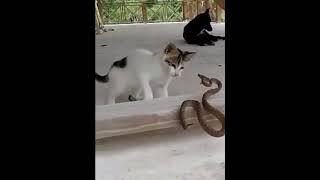Our Siberian Mikhail Babushkin - see info below - and neighbors' cat named Lenny. Shot in April 2017 but these two cat guys are still friends (sort of). Now some interesting facts; A black cat is a domestic cat with black fur that may be a mixed or specific breed, or a common domestic cat of no particular breed. The Cat Fanciers' Association (CFA) recognizes 22 cat breeds that can come with solid black coats. The Bombay breed is exclusively black. All-black fur pigmentation is slightly more prevalent in male cats than female cats. Most black cats have golden irises due to their high melanin pigment content.
Mikhail Babushkin (Russian: Михаи́л Серге́евич Ба́бушкин; October 6, 1893 – May 18, 1938) was a Soviet polar aviator and a Hero of the Soviet Union (June 27, 1937). Together with Mikhail Vodopyanov, he was the first to land an airplane on the North Pole.
Mikhail Babushkin was born in a village of Bordino (which was merged into the city of Moscow in 1960), started military service in 1914, graduated from Gatchina aviation school (one of the first Russian aviation schools) in 1915. Since 1923 he served in the Arctic aviation. He took part in an expedition to rescue Umberto Nobile in 1928, and in the Chelyuskin expedition in 1933. He took part in the flights to the Soviet drifting ice station "North Pole-1" in 1937. Between 1937 and 1938, Mikhail Babushkin participated in a search for Sigizmund Levanevsky. He died in 1938 in a flight accident and was interred at the Novodevichy Cemetery. Mikhail Babushkin was also a recipient of the Order of Lenin. A district of Moscow (in the area where he was born) and the Babushkinskaya station of the Moscow Metro are named after him.
More awesome info - just in time for Caturday! Any cat whose fur is a single color, including black, is known as a "solid" or "self". A "solid black" cat may be coal black, grayish black, or brownish black. Most solid-colored cats result from a recessive gene that suppresses the tabby pattern. Sometimes the tabby pattern is not completely suppressed; faint markings may appear in certain lights, even on a solid black cat. A cat having black fur with white roots is known as a "black smoke".
A black cat "rusting" (coat turning a lighter brown shade) in sunlight
Black cats can also "rust" in sunlight, the coat turning a lighter brownish-red shade. Eumelanin, the pigment that is required to produce the black fur, is somewhat fragile, so the rusting effect can be more pronounced in cats that frequently spend time in the sun. A rarer situation that can also cause rusting is a deficiency of the amino acid tyrosine, which is required to produce eumelanin. In addition to the Bombay, the Cat Fanciers' Association allows solid black as a color option in 21 other breeds. The color description for those breeds is: Black: dense coal black, sound from roots to tip of fur. Free from any tinge of rust on the tips. Nose leather: black. Paw pads: black or brown.
The exceptions are: Oriental – Ebony: dense coal black. Free from any tinge of rust on tips or smoke undercoat. Nose leather: black. Paw pads: black or brown.
Sphynx – Black: black. One level tone from nose to tip of tail. Nose leather: black. Paw pads: black or brown.
Ragamuffin – Although black is not specifically mentioned, the standard allows for "any color, with or without white", so technically speaking, an all-black Ragamuffin would be allowed under the breed standard
The superstitions surrounding black cats varies from culture to culture, but black cats have positive associations in the Celtic Nations and Japanese folklore .Black cats were sacred in Celtic mythology. Scottish lore holds that a black cat's arrival at a new home signifies prosperity, while Welsh lore states that a black cat brings good health:
Cath ddu, mi glywais dd’wedyd,
A fedr swyno hefyd,
A chadw’r teulu lle mae’n byw
O afael pob rhyw glefyd.
A black cat, I’ve heard it said,
Can charm all ill away,
And keep the house wherein she dwells
From fever’s deadly sway.
—A Welsh folklore rhyme, 1896
The mix of positive and negative associations in Great Britain may have given rise to the later belief that black cats were omens of both good and bad luck. One tradition states that if a black cat walks towards someone, it is said to bring good fortune, but if it walks away, it takes the good luck with it.[8] This tradition was reversed at sea where 18th century Pirates came to believe that a black cat would bring bad luck if it walks towards someone, and good luck if it walks away from someone. It was also believed that if a black cat walks onto a ship and then walks off it, the ship is doomed to sink on its next trip.Furthermore, it is believed that a lady who owns a black cat will have many suitors.
In England, as with other Germanic cultures, some areas would associate black cats with witches and bad luck.
Mikhail Babushkin (Russian: Михаи́л Серге́евич Ба́бушкин; October 6, 1893 – May 18, 1938) was a Soviet polar aviator and a Hero of the Soviet Union (June 27, 1937). Together with Mikhail Vodopyanov, he was the first to land an airplane on the North Pole.
Mikhail Babushkin was born in a village of Bordino (which was merged into the city of Moscow in 1960), started military service in 1914, graduated from Gatchina aviation school (one of the first Russian aviation schools) in 1915. Since 1923 he served in the Arctic aviation. He took part in an expedition to rescue Umberto Nobile in 1928, and in the Chelyuskin expedition in 1933. He took part in the flights to the Soviet drifting ice station "North Pole-1" in 1937. Between 1937 and 1938, Mikhail Babushkin participated in a search for Sigizmund Levanevsky. He died in 1938 in a flight accident and was interred at the Novodevichy Cemetery. Mikhail Babushkin was also a recipient of the Order of Lenin. A district of Moscow (in the area where he was born) and the Babushkinskaya station of the Moscow Metro are named after him.
More awesome info - just in time for Caturday! Any cat whose fur is a single color, including black, is known as a "solid" or "self". A "solid black" cat may be coal black, grayish black, or brownish black. Most solid-colored cats result from a recessive gene that suppresses the tabby pattern. Sometimes the tabby pattern is not completely suppressed; faint markings may appear in certain lights, even on a solid black cat. A cat having black fur with white roots is known as a "black smoke".
A black cat "rusting" (coat turning a lighter brown shade) in sunlight
Black cats can also "rust" in sunlight, the coat turning a lighter brownish-red shade. Eumelanin, the pigment that is required to produce the black fur, is somewhat fragile, so the rusting effect can be more pronounced in cats that frequently spend time in the sun. A rarer situation that can also cause rusting is a deficiency of the amino acid tyrosine, which is required to produce eumelanin. In addition to the Bombay, the Cat Fanciers' Association allows solid black as a color option in 21 other breeds. The color description for those breeds is: Black: dense coal black, sound from roots to tip of fur. Free from any tinge of rust on the tips. Nose leather: black. Paw pads: black or brown.
The exceptions are: Oriental – Ebony: dense coal black. Free from any tinge of rust on tips or smoke undercoat. Nose leather: black. Paw pads: black or brown.
Sphynx – Black: black. One level tone from nose to tip of tail. Nose leather: black. Paw pads: black or brown.
Ragamuffin – Although black is not specifically mentioned, the standard allows for "any color, with or without white", so technically speaking, an all-black Ragamuffin would be allowed under the breed standard
The superstitions surrounding black cats varies from culture to culture, but black cats have positive associations in the Celtic Nations and Japanese folklore .Black cats were sacred in Celtic mythology. Scottish lore holds that a black cat's arrival at a new home signifies prosperity, while Welsh lore states that a black cat brings good health:
Cath ddu, mi glywais dd’wedyd,
A fedr swyno hefyd,
A chadw’r teulu lle mae’n byw
O afael pob rhyw glefyd.
A black cat, I’ve heard it said,
Can charm all ill away,
And keep the house wherein she dwells
From fever’s deadly sway.
—A Welsh folklore rhyme, 1896
The mix of positive and negative associations in Great Britain may have given rise to the later belief that black cats were omens of both good and bad luck. One tradition states that if a black cat walks towards someone, it is said to bring good fortune, but if it walks away, it takes the good luck with it.[8] This tradition was reversed at sea where 18th century Pirates came to believe that a black cat would bring bad luck if it walks towards someone, and good luck if it walks away from someone. It was also believed that if a black cat walks onto a ship and then walks off it, the ship is doomed to sink on its next trip.Furthermore, it is believed that a lady who owns a black cat will have many suitors.
In England, as with other Germanic cultures, some areas would associate black cats with witches and bad luck.
- Catégories
- Chats de Race Bombay
- Mots-clés
- black cat, pets, animals














Commentaires